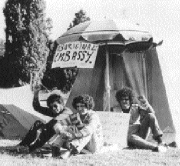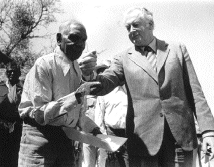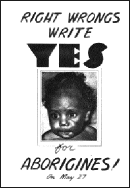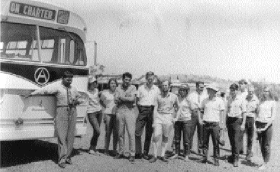Chapter
1 A
BRIEF LOOK AT A LONG HISTORY
|
The past is never
fully gone. It is absorbed into the present and the future. It stays
to shape what we are and what we do.
Sir William Deane,
Governor-General, Inaugural Vincent Lingiari Memorial Lecture, August
1996
|
|
The
Aboriginal cause, loosely defined, has been advanced mainly by virtue
of the fact that Australians of all backgrounds know more about Aboriginal
history than they did in the past.
Gerard
Henderson, Sydney Institute (1996)
|
In 1991, legacies of Australia's
past remained as a troubling challenge in the present.
The nation faced a significant
challenge as it entered the decade leading to the centenary of its Federation.
Would it deny the wounds of its past or would it seek to heal them? Would it
ignore the dispossession, disadvantage and rights of Aboriginal and Torres Strait
Islander peoples, or would it seek to address them? Would it assume that 'she'll
be right' or would it act to make things right?
A century before, in the
decade leading to Federation on 1 January 1901, Australians had ignored Aboriginal
and Torres Strait Islander peop les
as they debated the foundation of the nation.
But in 1991, the Commonwealth
Parliament showed vision, leadership and unity when it voted unanimously to
establish the Council for Aboriginal Reconciliation and a formal reconciliation
process. The Parliament noted that there had been no formal process of reconciliation
to date, and that it was 'most desirable that there be such a reconciliation'
by the year 2001, the centenary of Federation.
The Parliament's decision
to shape a better future can only be understood against the backdrop of a past
not yet dealt with, and therefore still a dark shadow on the present.
The
past not yet dealt with
Britain established its
colony at Sydney Cove on 26 January 1788 without consent and without negotiating
a fair deal with the original inhabitants. In the following decades, other colonies
were also established around the continent to which convicts were exported and
in which free settlers and emancipists were granted title to lands.
Many Aboriginal people
were dispossessed and displaced from their lands, forced into reserves, and
killed in battles for their land, or by hunting parties and poisoning of waterholes.
Many died from introduced diseases. In the second half of the 19th
Century, Torres Strait Islanders also lost their independence when the Queensland
Government annexed the Torres Strait Islands. Many were also killed by introduced
diseases.
As numbers declined and
traditional lifestyles and cultures were disrupted, Aboriginal and Torres Strait
Islander peoples became marginalised. Many were moved, often forcibly, to missions
or government reserves. Some became fringe dwellers on the outskirts of cities
and towns, while others managed a meagre living in the casual labour force of
rural and outback Australia. They were no longer allowed to live as they had
done for tens of thousands of years, but neither were they able to become equal
partners and citizens in the wider society that had taken their land.
|
It
has been a slow and painful process for all of us to talk about
our shared history... The simple historical truth needs to be put
into the most important legal document for our entire national life - the
Constitution.
Julie
McCrossin, television personality (1998)
|

The Tent Embassy,
Canberra, 1972.
Photo: Peter Wells/
Canberra Times
|
The social impact
Many official reports have
noted that Aboriginal and Torres Strait Islander peoples are the most disadvantaged
people in Australian society today. These reports also conclude that this situation
stems directly from colonisation, dispossession from their lands and forced
marginalisation, depriving them of the rights and opportunities taken for granted
by other citizens.
Nevertheless, many
Aboriginal and Torres Strait Islander peoples fought for their rights and maintained
their cultures. More than 200 years after the first British settlement in Sydney,
Aboriginal and Torres Strait Islander peoples can celebrate their survival spiritually,
physically and culturally.
In the wider society, ever
since the early days of colonisation and settlement, dissenting voices have
been raised, arguing against the harsh treatment of Aboriginal and Torres Strait
Islander peoples and calling for recognition of their rights, including for
just agreements over land.
Once a minority view, and
often not heard for years at a time, over the last 30 years or so the need to
address these issues has become a mainstream view, growing hand in hand with
the emergence of movements and organisations of Aboriginal and Torres Strait
Islander peoples working for their own rights.
Federation
In the decade of public
debate leading up to Federation in 1901, Aboriginal and Torres Strait Islander
peoples were not involved in any of the conventions and consultations, and were
largely ignored. As the 'Founding Fathers' hammered out a draft Constitution
of the Commonwealth of Australia, they discussed Aboriginal people only to:
1. specifically deny
the new Commonwealth Parliament the power to make laws for Aboriginal people;
and
2. exclude the necessity
to count them in the census.
These exclusions reflected
the exclusion of Aboriginal and Torres Strait Islander peoples from Australian
society generally, and from the rights, responsibilities and benefits which
other Australian citizens enjoyed.
|
The
Federation itself was founded on the assumption that the Aborigines
would, quite literally, disappear.
Gough
Whitlam, Vincent Lingiari Memorial Lecture, 1997
|

Prime Minister
Gough Whitlam pours soil into the hands of Gurindji elder Vincent Lingiari
in 1975 symbolising the return of traditional lands to the Gurindji people.
Photo: courtesy AIATSIS
|
A gradual awakening
From the time of Federation
it took two thirds of a century for Australians to recognise that the Constitution
of 1901 had to be changed to give the Commonwealth Parliament the power to make
laws for Aboriginal and Torres Strait Islander peoples and to ensure that Aboriginal
people and Torres Strait Islanders would be counted in the census.
Even then, it took a long
10-year campaign by Aboriginal and Torres Strait Islander people and their supporters
before both sides of the Parliament agreed that a referendum should be held
to change the Constitution in these ways. In the
historic referendum of 27 May 1967, over 90 per cent of eligible
voters supported the proposed changes, by far the most overwhelming 'Yes' vote
at an Australian referendum.
In the years before that,
other events were beginning to arouse the nation's conscience and reshape our
understanding of our own history and of the legacies which that history had
bequeathed to Aboriginal and Torres Strait Islander peoples.
In 1965, the Freedom Ride
through north-western NSW exposed to public gaze the racism experienced by Aboriginal
people and the poverty and degradation of their living conditions. In 1966,
Vincent Lingiari led the Gurindji people in a walk-off and strike from the Wave
Hill cattle station in the Northern Territory, owned by Britain's Lord Vestey.
The Gurindji's initial protest was over wages and living conditions but soon
became a claim for the return of their traditional lands.
The effects of these and
other similar events rippled across the nation, raising the nation's awareness
and stimulating the modern movements for the rights of Aboriginal and Torres
Strait Islander peoples.
The years after the 1967
Referendum saw the growth and development of these movements and of the autonomous
organisations of Aboriginal people and Torres Strait Islanders. In 1972, the
Aboriginal Tent Embassy was established on the lawns in front of Parliament
House in Canberra.
The return of some of the
Labor Gurindji people's traditional lands in 1975, nine years after the Wave
Hill strike, by the then Labor Prime Minister, Gough Whitlam, marked a sign
of hope for other Aboriginal and Torres Strait Islander peoples that their land
rights too would be recognised.
In 1976, the Liberal Government
of Malcolm Fraser put legislation through the Federal Parliament which became
the Aboriginal Land Rights (Northern Territory) Act 1976 , the first
land rights legislation in Australia.
Then in 1992, the High
Court made its historic Mabo judgment after a case lasting eight years
in which Eddie Mabo and four other Torres Strait Islanders from Mer (Murray
Island) asked for legal recognition of their traditional native title rights
to their island. In a landmark judgment, the High Court overturned the fallacy
of terra nullius (land belonging to no one)
and recognised native title within the common law of Australia.
Subsequently, the Parliament
passed the Native Title Act 1993 which was amended in 1998 following
the High Court's Wik judgment.
|

1967 Referendum
Poster.
Photo: courtesy AIATSIS
|
Disadvantage and injustice
In the 25 years following
the 1967 referendum, awareness and understanding of the injustices and inequalities
suffered by Aboriginal and Torres Strait Islander peoples grew in significant
sections of the wider community. The nation began to realise that decisive measures
were required to address these disadvantages which contradicted the 'fair go'
image of the 'lucky country'.
No formal agreement
During the whole process
of colonisation and settlement, not once did Britain or those in authority in
the colonies conclude a formal treaty or agreement with the original inhabitants.
Australia is the only Commonwealth country that never signed an official treaty
with its Indigenous peoples.
In the 1830s and 1840s
various eminent people in the colonies in Sydney, Hobart, Perth and Adelaide
argued that, for example, treaties should be entered into with Aboriginal people
and that their rights to land should be respected.
|
It
is hard to realise that the history we were taught of a great empty
land being settled by brave explorers was largely false. It is hard
for us to understand that the real history of Australia was quite
different from that which we were taught as children.
The
Rt Hon Malcolm Fraser, Vincent Lingiari Memorial Lecture (2000)
|
... the
question of how the British acquired the sovereignty over Australia in
the absence of conquest or treaty remains.
Professor
Henry Reynolds, historian (1998)
|
Such arguments did not produce
results, and Aboriginal and Torres Strait Islander peoples were never formally
recognised as the first inhabitants of this continent or as one of the oldest
cultures in the world.
Yet Aboriginal and Torres
Strait Islander peoples never gave up their own yearnings for recognition, rights
and justice.
In 1963, the Yolngu people
of Arnhem Land presented federal Parliament with their Bark Petition in protest
at a government decision to grant leases for bauxite mining on land excised
from their reserve.
In 1972, the Larrakia people
of the Darwin area requested treaties.
During the Bicentennial
year of 1988, in which the wider society celebrated 200 years since British
settlement, many Aboriginal people took the opportunity through demonstrations
and other means to point to the legacies of that settlement for them. 'We have
survived' was a rallying call.
In June 1988, the Chairmen
of the Central and Northern Land Councils, Wenten Rubuntja and Galarrwuy Yunupingu,
presented the then Prime Minister, Bob Hawke, with the Barunga Statement. This
called for Aboriginal self-management, a national system of land rights, compensation
for loss of lands, respect for Aboriginal identity, an end to discrimination,
and the granting of full civil, economic, social, political and cultural rights.
It also called on the Commonwealth Parliament:
to negotiate with us a
Treaty or Compact recognising our prior ownership, continued occupation and
sovereignty and affirming our human rights and freedoms.
In response, the Prime
Minister and the then Minister for Aboriginal Affairs, Gerry Hand, signed a
five-point statement which included:
1. The Government
affirms that it is committed to work for a negotiated Treaty with Aboriginal
people.
2. The Government
sees the next step as Aborigines deciding what they believe should be in the
Treaty.
However, as with similar
proposals a few years earlier, broad agreement could not be reached on these
proposals in Parliament, the wider community, or among Aboriginal and Torres
Strait Islander peoples.
|
We
cannot rewrite history, but we can shape the future.
The
Hon Kim Beazley (1997)
|

Freedom Ride
in northern NSW 1965.
Photo: State
Library of New South Wales
|
The 1991 Report of the
Royal Commission into Aboriginal Deaths in Custody pointed out underlying
reasons for facts such as that Aboriginal and Torres Strait Islander males
were 28 times more likely than other males to be taken into custody. These
and other expressions of disadvantage, such as much lower life expectancy
for Aboriginal and Torres Strait Islander peoples and higher birth mortality
are the product of the history of dispossession and social marginalisation.
The cycle of poverty, poor health and little education trapped Aboriginal
and Torres Strait Islander Australians in an existence very different to
most other Australians.
For these reasons,
the Royal Commission in its final recommendation suggested:
That all political
leaders and their parties recognise that reconciliation between the Aboriginal
and non-Aboriginal communities in Australia must be achieved if community
division, discord and injustice to Aboriginal people are to be avoided.
Soon after, the Commonwealth
Parliament voted to establish the Council for Aboriginal Reconciliation
with the object of:
promoting a process
of reconciliation between Aborigines and Torres Strait Islanders and the
wider Australian community...
|
